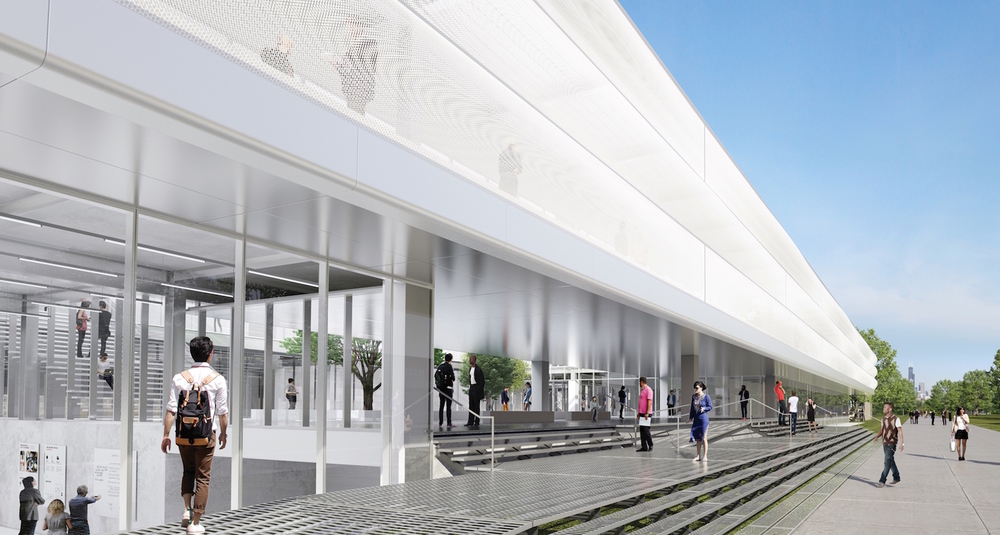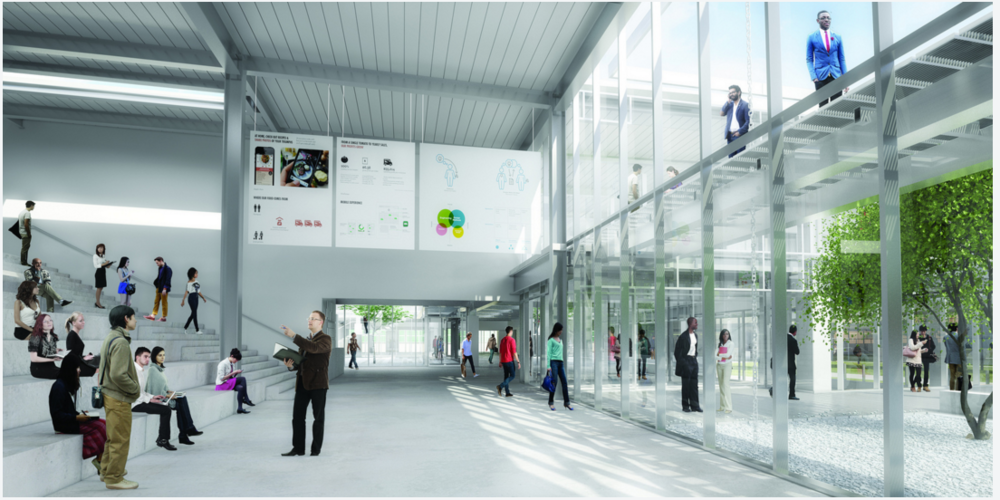
Granddaddy of it all: Mies models IIT’s Crown Hall.
by JOHN GREGERSON | March 24, 2016
First came the name change — from Illinois Institute of Technology to Illinois Tech. Now comes word that the iconic Mies-designed university on Chicago’s south side is steps closer to embracing even more invigorating entrepreneurial and interdisciplinary collaboration with the planned Ed Kaplan Family Institute for Innovation and Tech Entrepreneurship.
When completed, the $40-million, 92,000-sq-ft undergraduate facility will “nurture the advancement of creative ideas, foster interdisciplinary and external collaboration, and create a culture that enables innovation and tech entrepreneurship to flourish,” says the school, particularly in the areas of science, technology, engineering and mathematics (STEM). All told, the new Kaplan will serve as home to Illinois Tech’s Institute of Design, Interprofessional Projects Program, Entrepreneurship Academy, Leadership Academy, Jules Knapp Entrepreneurship Center, and the Idea Shop.

Obama pursuer Ronan
As designed, the forward-thinking facility acknowledges the university’s rich architectural past, rooted in a 120-acre campus master plan by Modernist master Ludwig Mies van der Rohe, who designed no fewer than 12 buildings on campus. Mies also served as Dean of IIT’s College of Architecture from 1938 to 1958, so his legacy continues to loom large.
Today, Kaplan designer John Ronan is also an Illinois Tech professor of architecture, as well as a finalist to design the new Obama Presidential Center. With Kaplan, he opted for sleekness and scale evocative of the existing campus. “The design is a thoughtful and sensitive contribution to the university’s important architectural legacy, yet is forward looking in its approach to the flexible and technologically advanced learning facilities needed today,” explains Ronan, in a public statement.
The building, itself, employs technologically advanced systems to promote sustainable design. Kaplan’s second floor, which cantilevers over the ground floor for purposes of shading, will be sheathed in a dynamic facade made of ETFE (Ethylene Tetrafluoroethylene) foil cushions, the first such use of the material in Chicago. The system incorporates three layers of film, the middle of which can be manipulated to press against outer or inner layers, to either block or accommodate daylighting, depending on the time of day. The result is more efficient use of heating and cooling. At a weight of only 1% of glass, the material imbues Kaplan with a light, cloud-like appearance, according to Ronan.
Kaplan also will incorporate an advanced HVAC system, with water-filled tubing embedded in a concrete-filled metal deck to achieve radiant heating and cooling. Not surprisingly, the facility also will be seeking LEED Silver certification upon completion.

Light, airy, by design: EFTE’s first use in Chicago allows abundant light. (Rendering by John Ronan Architects.)
To blur boundaries between campus and building, Kaplan will be organized around a pair of open-air courtyards through which visitors enter the facility. To promote collaboration and interaction within, circulation is indirect and dispersed, with large, open horizontal floor plates affording views of multiple spaces from a single vantage point. Ronan also inserted openings in floor plates to provide views of activity from above and below, further promoting a sense of community within the facility.
The facility’s vast expanses of open space also promote flexibility, allowing users to configure and reconfigure areas with sound-isolating demountable partitions.
Practical applications
Among other initiatives, Kaplan faculty and students intend to develop relationships with industry partners and organizations, including early-stage start ups, entrepreneurs, venture capitalists and private equity funds. Application, rather than acquisition, of knowledge is the goal.
Ronan is founder of Chicago-based John Ronan Architects, an enterprise that achieved prominence in 2004 with its design of 500,000-square-foot Perth Amboy High School in New Jersey. The firm has received two Institute National Honor Awards from the American Institute of Architects, for the Gary Comer Youth Center and the Poetry Foundation, both located in Chicago.
Work on Kaplan comes on the heels of renovations to Illinois Tech’s John T. Rettaliata Engineering Center, completed in September 2015. The 50-year-old structure was designed by Myron Goldsmith, a student of van der Rohe. Fittingly enough, Mies’s grandson, architect Dirk Lohan, of Lohan Anderson, was charged with undertaking the project while retaining its historical significance. The successful update marked the first major construction project on Illinois Tech’s Mies campus since completion of the McCormick Tribune Campus Center in 2003.
All in the family: Mies’ grandson Dirk Lohan oversaw design of the Rettaliata Center’s respectful renovation.




Discussion
Be the first to leave a comment.
You must be a member of the BuiltWorlds community to join the discussion.